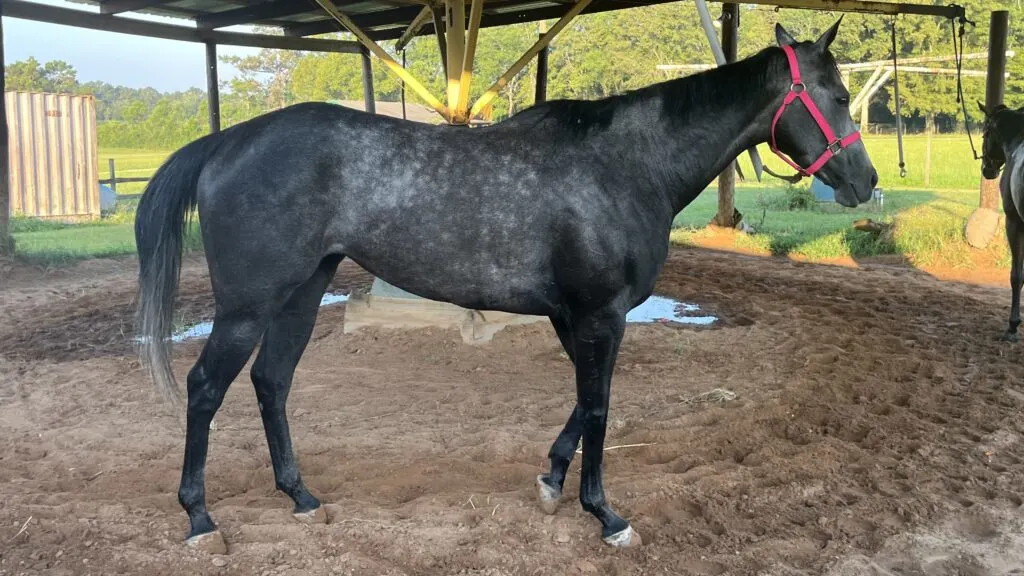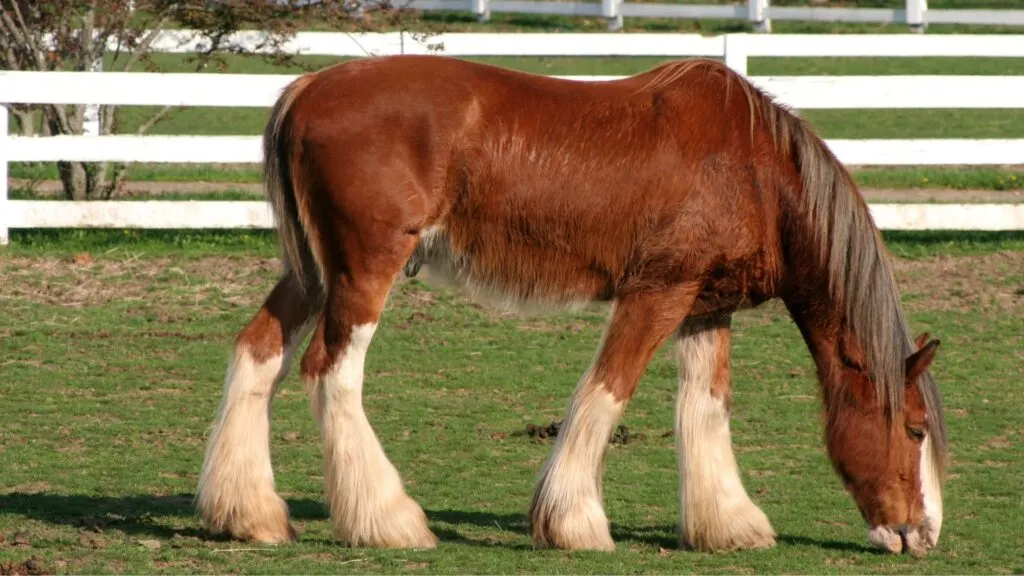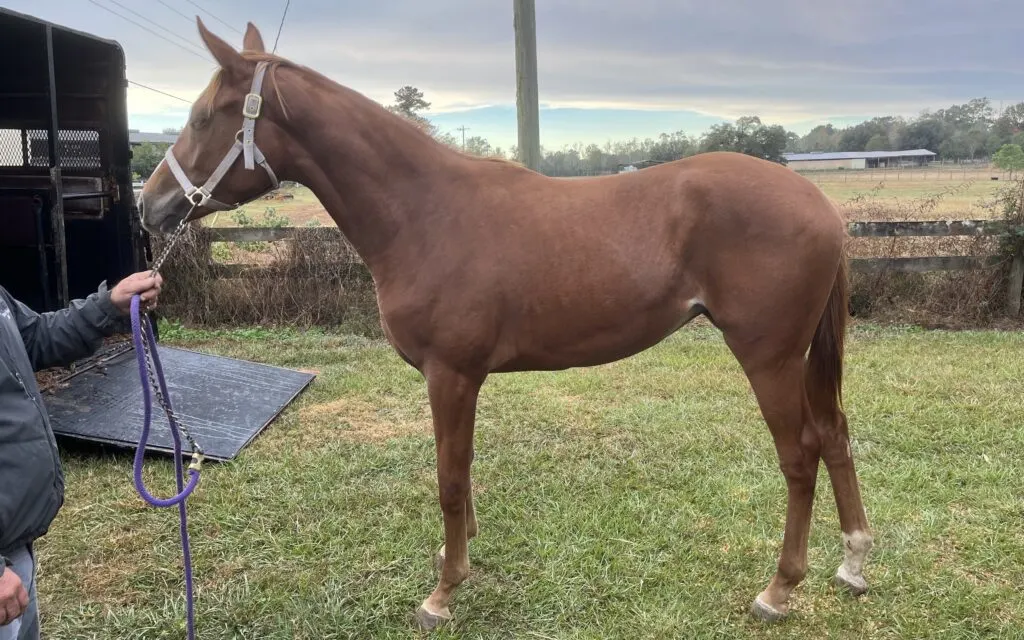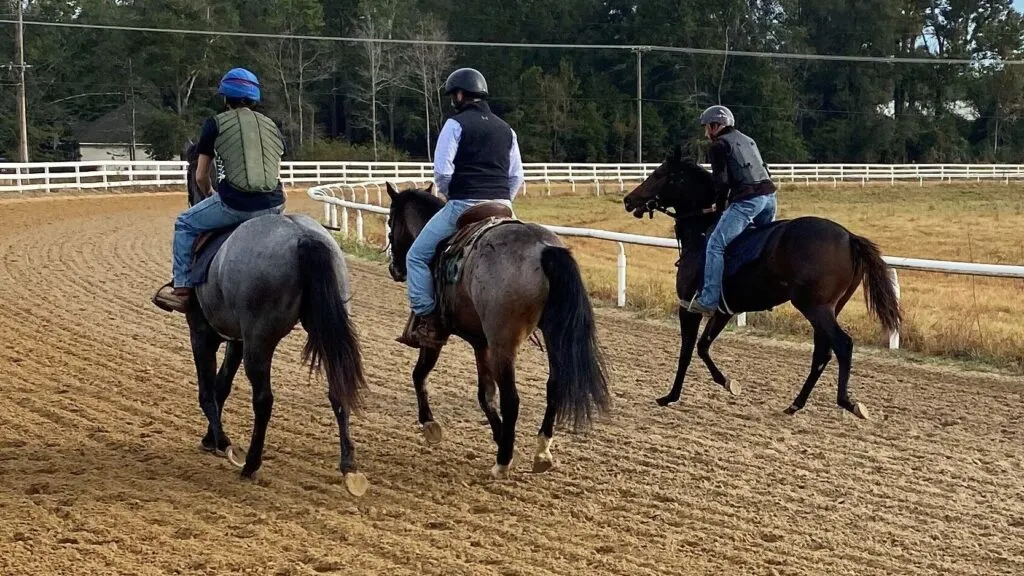Last updated: February 26, 2024
Any links on this page that lead to products on Amazon are affiliate links and I earn a commission if you make a purchase. Thanks in advance – I really appreciate it!
Did you know that not all horses stop growing at the same age? While most horses reach their full height by age five, larger breeds can continue to grow until they’re about eight years old. This fact isn’t trivia; it’s a crucial piece of knowledge for anyone involved in equine care and training.
My work across various breeds has provided me with unique insights into the nuances of equine growth. In this article, I guide you through the stages of horse growth, addressing the key question: when do horses stop growing?

Understanding Horse Growth
Horse growth is a complex, fascinating process essential for anyone involved in equine care and training. It involves distinct stages with specific physical and behavioral changes.
The Growth Process Explained
- Birth to Yearling:
- Rapid growth in the first year.
- Significant milestones in height and weight.
- Yearling Stage:
- Slower growth pace.
- Bodies start to take on adult proportions.
- Adolescent Phase (Up to 4 Years):
- Gradual reach to adult height.
- Increase in muscle mass; breed-specific traits become pronounced.
- Mature Phase:
- Full height reached, though larger breeds may continue to grow.
- Further muscle mass and size increase.
Why Understanding Growth Stages Matters
- For Caretakers:
- Informs nutrition, training, and healthcare decisions.
- Tailors training regimens to avoid injuries and ensure proper development.
- Setting Expectations:
- Helps in setting realistic training and development goals.
- Avoids premature rigorous training.
Growth Variations Among Breeds
- Breed-Specific Growth:
- Thoroughbreds and Arabians mature faster than larger breeds like Warmbloods or Clydesdales.
- Variations in size and time to reach emotional and physical maturity.
Understanding each growth stage and recognizing breed-specific growth patterns is crucial for optimal care and training, ensuring the well-being and health of horses throughout their lives.

Growth Stages of Horses
Understanding the growth stages of horses is crucial for providing appropriate care and training at each phase of their development. Let’s explore these stages in detail:
Foal Phase (Birth to 12 months)
- Physical Changes: This phase is characterized by rapid growth. Foals typically stand and nurse within hours of birth and undergo significant changes in height and weight. Their legs, which are disproportionately long at birth, begin to look more proportionate as they grow.
- Behavioral Changes: Foals are curious and playful yet dependent on their mothers. This period is critical for socialization as they learn to interact with other horses and humans.
- Care Tips: Proper nutrition for both the mare and foal is essential. Early handling and gentle training can begin in this stage, focusing on basic commands and desensitization.
Yearling Phase (12 to 24 months)
- Developmental Milestones: Yearlings continue to grow rapidly, though the rate slows compared to the foal phase. They start to resemble miniature adult horses.
- Physical Development: This stage sees the development of permanent teeth and the shedding of the foal coat. The yearling’s body begins to catch up with leg length.
- Care Tips: Balanced nutrition is key to supporting their growth. This is also a time to start more structured training, focusing on groundwork and basic manners.
Adolescent Phase (2 to 4 years)
- Physical Changes: Horses in this stage are nearing their adult height, but muscle mass and breadth continue to develop. They start to lose their gangly appearance and take on a more mature physique.
- Mental Development: Despite physical growth, they may still exhibit playful or juvenile behavior. This is also when mares may begin their estrous cycles.
- Care and Training: This is a critical time for training, as horses are physically capable of more challenging tasks. However, it’s important to match training intensity with their physical and mental maturity.
Mature Phase (4+ years)
- Reaching Full Size: Most horses reach their full height by this age, but some, especially larger breeds, may continue growing. The focus shifts from growth to maintaining a healthy weight and muscle tone.
- Physical and Emotional Maturity: Horses are generally considered fully mature by this age, both physically and mentally, although individual temperament can vary.
- Ongoing Care: Regular exercise, proper nutrition, and health care are essential to maintain their condition. Training can be more intensive, depending on the horse’s discipline and individual capabilities.
| Growth Stage | Age Range | Key Characteristics |
|---|---|---|
| Foal Phase | Birth to 12 months |
– Rapid growth, achieving up to 75% of mature height. – Noticeable daily physical changes. – Dependency on mare’s milk and gradually introduced to solid food. |
| Yearling Phase | 12 to 24 months |
– Growth rate starts to slow down. – Increasing independence; exploration and playful behavior. – Diet transitions more towards solid foods and forage. |
| Adolescent Phase | 2 to 4 years |
– Continued growth but at a much slower pace. – Physical and mental maturity develop, but still playful. – Knees commonly close around two years, but always confirm with x-rays. |
| Mature Phase | 4+ years |
– Typically reach maximum height around 4 or 5 years. – Bones in the neck and spine continue to grow until around 6 years. – By the end of this phase, the horse is considered fully grown. |
Each stage of a horse’s growth requires specific care and attention. By understanding these stages, owners and trainers can ensure their horses develop into healthy, well-adjusted adults.

Breed-Specific Growth Patterns
While the basic stages of horse growth are universal, the rate and nuances of development can vary significantly among different breeds. Understanding these breed-specific patterns is not only essential for tailored care and training but also provides insights into the broader question: when do horses stop growing?
This knowledge is crucial for anyone involved in equine care, as it helps in making informed decisions about nutrition, training, and overall management based on the specific needs of each breed.
Quarter Horses
- Growth Characteristics: Known for their muscular build, Quarter Horses typically reach physical maturity faster than larger breeds. Most will reach their full height by the age of four or five.
- Expert Insight: Dr. Kevin Cooper, an equine veterinarian, notes, “Quarter Horses often develop muscular strength early, making them suitable for various disciplines at a younger age compared to larger breeds.”
Growth Chart for Different Breeds
| Breed | Age at Full Height | Characteristics and Notes |
|---|---|---|
| Quarter Horse | 4-5 years | Quick to mature, muscular build, versatile in disciplines |
| Thoroughbred | 4-5 years | Fast growth, bred for speed, may fill out till 6 years |
| Arabian | 6-7 years | Slower growth, known for endurance and stamina |
| Draft Horse | 7-8 years | Larger breeds, slower growth, longer to reach full size |
Thoroughbreds
- Growth Characteristics: Thoroughbreds, famed for their racing prowess, also grow quickly. They usually reach their full height by age four but may continue to fill out and gain muscle until five or six.
- Racehorse Owner Quote: “Thoroughbreds are bred for speed and agility, which is reflected in their rapid growth. However, their training should still be paced to avoid stress on their developing bones,” advises horse trainer and owner Eric Frenchy.
Arabians
- Growth Characteristics: Arabians are known for their endurance and often have a slower growth rate. They may not reach full maturity until six or seven years of age.
- Expert Insight: “Arabians’ slower growth rate allows for a longer window of development, which contributes to their renowned stamina and longevity in competitive disciplines,” explains Lauren Sage, an Arabian horse breeder.

Draft Horses
- Growth Characteristics: Larger breeds like Clydesdales and Percherons, categorized as draft horses, have the longest growth period. They may continue growing in height and mass until they are seven or eight years old.
- Breeder Quote: “Due to their size, draft breeds require careful monitoring during growth to ensure proper bone and joint development. Their training should be adjusted accordingly,” states Richard Jacobson, a specialist in draft breeds.
Breed-Specific Considerations
- Nutrition and Training: Each breed has unique nutritional needs and training considerations based on its growth pattern. For instance, high-energy diets may be suitable for fast-growing breeds like Thoroughbreds, while draft breeds may require more focus on joint health.
- Health Monitoring: Regular veterinary check-ups are crucial to monitor growth-related health issues, which can vary by breed. For example, Arabians may be more prone to certain genetic conditions that can affect growth.
Recognizing these breed-specific growth patterns enables horse owners and trainers to provide more personalized care. By understanding the unique needs of each breed, we can ensure their healthy development and well-being throughout their growth stages.

Factors Influencing Growth
A complex interplay of genetics, nutrition, and environmental factors influences the growth of horses. Understanding these can help provide optimal care for horses at different stages of their development. These factors also play a crucial role in determining when horses stop growing.
Genetics and Horse Growth
- Size and Growth Rate: Genetics play a pivotal role in determining a horse’s potential size and growth rate. The genetic makeup inherited from the parents can give a clear indication of how tall a horse might grow and how quickly it will reach maturity.
- Breed-Specific Traits: Specific genetic traits linked to different breeds also dictate growth patterns. For instance, draft breeds have genes predisposing them to larger size and slower growth, while lighter breeds like Arabians or Thoroughbreds have genetic traits for quicker growth.
- Expert Insight: “Different breeds of horses have been characterized as being fast growers or slow growers, but it is difficult to generalize because of the large variation between genetic lines within a breed.” Kris Hiney Extension Equine Specialist
Nutrition and Diet
- Foundation for Growth: Proper nutrition is the cornerstone of healthy growth in horses. A balanced diet rich in essential nutrients like proteins, vitamins, and minerals is crucial, especially during the rapid growth phases.
- Adjustments Over Time: The nutritional needs of a horse change as it progresses through different growth stages. Younger horses require more protein and energy for growth, while mature horses need a diet that maintains their health and condition.
- Veterinarian Advice: “Monitoring and adjusting a horse’s diet as it grows is essential to prevent nutritional deficiencies or excesses that can lead to growth-related health issues,” advises equine veterinarian Dr. Kevin Cooper.
Environmental Factors
- Exercise: Regular exercise is important for muscle development, bone strength, and overall health. However, the intensity and type of exercise should be appropriate for the horse’s age and growth stage.
- Social Interaction: Horses are social animals, and interaction with other horses plays a significant role in their mental and emotional development. Socialization can impact a horse’s behavior, temperament, and even its physical health.
- Overall Care: Factors such as living conditions, grooming, and healthcare also influence growth. Horses that are well-cared for in clean, safe environments with regular veterinary check-ups are more likely to reach their full growth potential.
- Research Study: A horse’s environment, including its exercise regimen, social interactions, and overall care, significantly impacts its growth and development, according to research published by Rutgers University.
As stated by Extension Equine Specialist Kris Hinley, “The promotion of healthy growth must coordinate genetics, nutrition, and exercise for the development of young horses.” A holistic approach that considers all these aspects is key to ensuring healthy growth and development in horses.
Signs of Maturity in Horses
Recognizing the signs of maturity is key to understanding when horses stop growing, ensuring their transition into adulthood is healthy and well-managed. It is also crucial for making informed decisions about training, breeding, and care. Maturity in horses encompasses physical and emotional aspects, each presenting distinct indicators.
Physical Indicators of Maturity
- Height and Weight Stability: One of the most apparent signs of physical maturity in horses is stabilizing height and weight. When a horse’s growth in height ceases, and its weight remains consistent, it’s a strong indicator that the horse has reached physical maturity.
- Bone Development: The development and fusion of growth plates in bones, particularly in the legs and spine, signify maturity. In most breeds, this occurs around the age of four to six. Veterinarians often use X-rays to confirm the closure of these growth plates.
- Musculature: Mature horses will have well-developed muscles appropriate to their breed and type of work. Their bodies will appear more proportionate compared to the lankier, less muscular build of younger horses.
- Growth and Bone Development in the Horse: When Is a Horse Skeletally Mature? This study goes into great detail about horse maturity and also provides a comparison to human growth. The study found that measures of bone growth and maturity support the hypothesis that the majority of growth is completed before the horse is two years old.
Emotional Maturity
- Behavioral Signs: Emotional maturity in horses is often reflected in their behavior. Mature horses typically exhibit a calmer, more composed demeanor compared to the playful, sometimes erratic behavior of younger horses.
- Training Response: A mature horse is generally more focused and responsive during training, capable of understanding and executing complex commands with greater ease.
- Social Dynamics: Mature horses often have established positions within herd hierarchies and exhibit more stable social interactions with other horses.
Assessing maturity in horses requires a holistic approach, considering both physical and emotional indicators. Understanding these signs helps ensure that horses are engaged in activities suitable for their stage of development, promoting their well-being and longevity.

When to Start Training and Riding
Determining the right time to start training and riding a horse is a decision that should be based on both the physical and emotional maturity of the horse. Starting too early or too late can have implications for the horse’s health and performance.
Guidelines on Appropriate Age for Training
- Physical Maturity: A key factor in deciding when to start training is the horse’s physical development. Generally, light training can begin when a horse is around two years old, focusing on groundwork and basic commands. However, more strenuous activities, like riding, should wait until the horse is at least three to four years old, when its bones and joints are more developed.
- Emotional Maturity: Emotional readiness is equally important. A horse should be mentally prepared to handle training, which typically occurs around the age of three to five. Signs of emotional maturity include a calm demeanor, ability to focus, and willingness to follow commands.
Risks of Starting Training Too Early
- Physical Risks: Training a horse too early, especially riding, can lead to joint and bone problems, as their bodies are not fully prepared to handle the weight and stress. This can result in long-term health issues and potentially shorten a horse’s active life.
- Emotional Risks: Horses trained too early may also experience stress and anxiety, leading to behavioral problems. They might become resistant to training or develop negative associations with handling and riding.
Expert Advice on Training Readiness
- Frank Delvato Veteran Horse Trainer: “When to start training a horse should be based on an individual assessment of its physical and emotional state. While age provides a general guideline, each horse develops at its own pace.”
Deciding when to start training and riding is closely linked to understanding when horses stop growing, as premature training can impact their physical development. Tailoring the training approach to each horse’s individual needs and development stage is crucial for their well-being and success in training.
Caring for Growing Horses
Proper care for growing horses is pivotal to ensure their healthy development. This involves a balanced approach to nutrition, exercise, and regular health check-ups, tailored to each stage of their growth.
Nutrition: Essential Nutrients for Different Growth Stages
- Foal to Yearling: In the early stages, foals require a diet rich in quality milk from the mare, gradually transitioning to solid foods. As they grow into yearlings, their diet should be rich in protein for muscle development, along with essential vitamins and minerals to support bone growth.
- Adolescent Horses: As horses enter adolescence, their nutritional needs shift slightly. While protein remains important, the focus also moves to energy, calcium, and phosphorus, crucial for continued bone and muscle development.
- Mature Horses: Once horses reach full size, their diet should maintain their health and condition rather than promote growth. This includes balanced rations of forage, grains, and supplements as needed to maintain a healthy weight and muscle tone.
- Expert Advice: Kris Hiney, Extension Equine Specialist, states, “Extremes in body condition created by under- or overfeeding must be avoided.”
Below is a YouTube video showing how you can use a string to determine the future height of a horse.
Exercise: Importance of Appropriate Physical Activity
- Early Stages: Light exercise, such as free play in a safe paddock, is important for young horses. It aids in muscle development and coordination.
- Increasing Intensity: As horses grow, structured exercise can be introduced. This includes groundwork, lunging, and eventually, light riding for older adolescents, always considering their physical limitations.
- Avoiding Overexertion: Overworking young horses can lead to joint and bone problems. Exercise intensity should be increased gradually based on the horse’s individual development.
Regular Health Check-Ups
- Monitoring Growth: Regular check-ups with a veterinarian are essential to monitor a horse’s growth and overall health. This includes tracking height and weight, as well as looking for any signs of developmental issues.
- Spotting Potential Issues: Early detection of health problems, such as joint abnormalities or nutritional deficiencies, can prevent more serious issues later on. Regular dental check-ups, deworming, and vaccinations are also crucial.
- Veterinarian Insight: Regular health assessments are crucial for growing horses. These check-ups help ensure that they are developing properly and allow for early intervention if any issues arise. Assessing the Health and Well-being of Horses, Purdue University.
Caring for growing horses requires a comprehensive approach that includes proper nutrition, appropriate exercise, and regular health check-ups. Tailoring these aspects to the horse’s specific growth stage is essential for their healthy development and well-being.
FAQs: When Do Horses Stop Growing?
At what age do most horses reach their full height?
Most horses reach their full height between 4 to 5 years of age, though this can vary depending on the breed. Knowing how to measure a horse is vital.
How can I tell if my horse has reached emotional maturity?
Emotional maturity in horses is often indicated by a calmer demeanor, more consistent behavior, and a focused response during training.
What are the risks of overfeeding a young horse?
Overfeeding can lead to obesity and developmental orthopedic diseases, affecting the horse’s growth and overall health.

Conclusion: When Do Horses Stop Growing?
A thorough understanding of the stages of horse growth and recognizing when horses stop growing are fundamental for anyone dedicated to equine care. As we conclude our exploration of horse growth it’s important to reflect on the key insights we’ve gathered and the responsibilities that come with horse ownership.
- Growth Stages: Horses progress through several distinct stages from birth to maturity – the Foal Phase, Yearling Phase, Adolescent Phase, and Mature Phase. Each of these stages is characterized by unique physical and behavioral changes.
- Breed-Specific Growth Patterns: Different horse breeds have varying growth rates and timelines, making it essential to understand the specific needs of your breed.
- Signs of Maturity: Physical maturity is marked by stabilization in height and weight, and the development of bones, while emotional maturity is reflected in a horse’s behavior and response to training.
- Importance of Care: Proper nutrition, regular exercise, and consistent health check-ups are crucial throughout all stages of a horse’s growth.
Owning and caring for horses is a deeply rewarding experience that requires commitment, knowledge, and empathy. It’s vital to provide horses with the appropriate care and environment they need to thrive at each stage of their growth.
Responsible horse ownership means being attentive to your horse’s physical and emotional needs and adapting your care strategies as they grow and mature. While this guide offers a foundational understanding, each horse is an individual with unique needs and circumstances.
I encourage you to seek expert advice for specific concerns or questions you may have about your horse’s growth and care. Consulting with equine veterinarians, nutritionists, and experienced trainers can provide you with tailored guidance and support, ensuring the best possible care for your equine companion.
Understanding the growth stages and maturity signs of horses is key to their well-being. As horse owners, our role is to nurture, guide, and care for these magnificent animals through every phase of their lives, ensuring they grow into healthy, happy, and well-adjusted adults.
Stay Connected and Informed:
- If you found this guide helpful, consider signing up for our newsletter for more insights and updates on horse ownership.
- For personalized advice or specific inquiries, feel free to contact me directly. I’m here to help.
Join the Conversation:
- I encourage you to share your thoughts, experiences, or questions in the comments section below. Let’s create a community of informed and passionate horse owners.
- Don’t forget to share this article with your network. Use the social share buttons to spread knowledge and love for horses.
Thank you for reading, and I look forward to connecting with you, whether it’s through our newsletter, direct communication, or in the comments section. Here’s to the thrilling journey of racehorse ownership!
Poll Question
Take the Next Step in Your Horse Care Journey
Embrace the role of a responsible horse owner. Stay informed, seek expert advice, and share your experiences. Your dedication makes all the difference in your horse’s health and happiness.
Join our community of passionate horse enthusiasts. Together, let’s ensure the best care for these magnificent animals.
Meet Miles Henry
An avid equestrian and seasoned racehorse owner, Miles Henry brings his extensive experience to the equine world, proudly associating with the AQHA, The Jockey Club, and various other equine organizations. Beyond the racetrack, Miles is an accomplished author, having published various books about horses, and is a recognized authority in the field, with his work cited in multiple publications.
🔗 Connect with Miles:
Twitter
Facebook
YouTube: Check out race highlights, horse care tips, and more!

